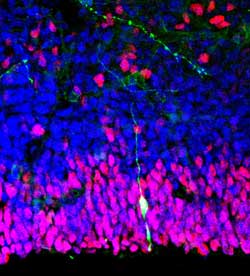The making and unmaking of stem-like, aggressive breast cancer cells

Reverting to a stem-like state, as shown here, helps breast cancer cells evolve around the blockages of current treatments. Image: Flickr/CodonAUG cc license.<br>
A University of Colorado Cancer Center study published as a featured article in the journal Oncogene shows how progesterone does just this – by suppressing a key microRNA, progestins return breast cancer cells to a stem-cell-like state in which they haven’t yet differentiated, and are thus more resistant to chemotherapies and more likely to carry a poor prognosis.
“The reason we were looking into the possible role of microRNAs in the dedifferentiation of breast cancer cells into this aggressive, chemo-resistant phenotype is that microRNAs tend to be good, druggable targets. Because one microRNA may regulate many genes involved in a cancerous signaling pathway, we hoped to find one target with many beneficial effects,” says Diana Cittelly, PhD, postdoctoral fellow at the CU Cancer Center and the paper’s first author. The study was a collaboration between the CU Cancer Center labs of Jennifer Richer, PhD, and Carol Sartorius, PhD.
Specifically, the study shows that progestins regulate miRNA-29 – a molecule that helps to decide which of a cell’s genes are and are not turned into proteins. This regulation of miRNA-29 creates a cascade that stimulates breast cancer cells to revert back to a stem-like state, marked by proteins CD44 and CK5. In animal models, these stem-like cells helped breast cancer evolve around the blockages of current treatments..
“We can manipulate this miRNA-29 in cell lines,” Cittelly says, “and we hope technology isn’t too far in the future that will allow us to deliver miRNA-29 in human cancers as well.”
Turn off the role of miRNA-29 and the hope is that breast cancers won’t be able to gain stem cell-like traits and lose their hormone dependence.
This work was supported by DOD BCRP Postdoctoral Fellowship W81XWH-11-1-0101 and DOD Idea Award BCRP W81XWH-11-1-0210.
Media Contact
More Information:
http://www.ucdenver.eduAll latest news from the category: Life Sciences and Chemistry
Articles and reports from the Life Sciences and chemistry area deal with applied and basic research into modern biology, chemistry and human medicine.
Valuable information can be found on a range of life sciences fields including bacteriology, biochemistry, bionics, bioinformatics, biophysics, biotechnology, genetics, geobotany, human biology, marine biology, microbiology, molecular biology, cellular biology, zoology, bioinorganic chemistry, microchemistry and environmental chemistry.
Newest articles

Bringing bio-inspired robots to life
Nebraska researcher Eric Markvicka gets NSF CAREER Award to pursue manufacture of novel materials for soft robotics and stretchable electronics. Engineers are increasingly eager to develop robots that mimic the…

Bella moths use poison to attract mates
Scientists are closer to finding out how. Pyrrolizidine alkaloids are as bitter and toxic as they are hard to pronounce. They’re produced by several different types of plants and are…

AI tool creates ‘synthetic’ images of cells
…for enhanced microscopy analysis. Observing individual cells through microscopes can reveal a range of important cell biological phenomena that frequently play a role in human diseases, but the process of…





















